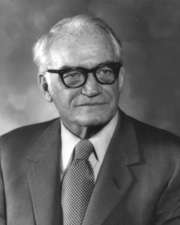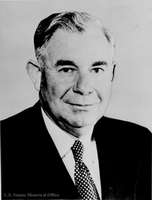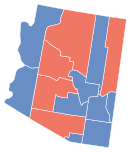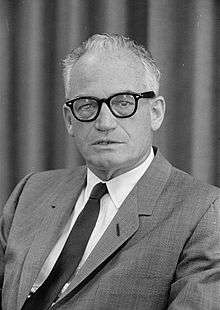United States Senate election in Arizona, 1952
| | |||||||||||||||||||||||||||
| |||||||||||||||||||||||||||
| |||||||||||||||||||||||||||
|
| |||||||||||||||||||||||||||
| County results | |||||||||||||||||||||||||||
| |||||||||||||||||||||||||||
| Elections in Arizona | ||||||||
|---|---|---|---|---|---|---|---|---|
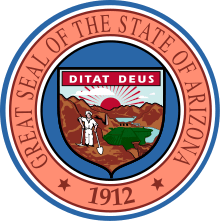 | ||||||||
|
||||||||
|
||||||||
The 1952 United States Senate election in Arizona was held on November 4, 1952. Incumbent Democratic U.S. Senator and Senate Majority Leader Ernest McFarland ran for re-election to a third term, but was defeated by the Republican nominee and future candidate for President of the United States, Barry Goldwater.[2]
Goldwater ran an aggressive campaign against the entrenched Democrat, accumulating over fifty thousand air-miles in his travels about the state, during which he delivered more than six hundred speeches. He defeated McFarland in the general election by a slim margin of 6,725 votes out of approximately 260,000 cast, which Goldwater attributed in part to the unpopularity of President Harry S. Truman and the backing of popular Wisconsin Senator Joseph McCarthy. Goldwater also launched a get out the vote effort in the northern part of the state, knowing the margin of victory would be slim, and received support from Republican Party campaign organizations and several prominent party members.[3]
The election marked the end of the Senate career of Ernest McFarland, who was first elected in 1940 and had served as co-chairman of the Joint Committee on Navajo-Hopi Indian Administration in addition to Senate Majority Leader. He was later elected Governor of Arizona in 1954 and ran unsuccessfully for his former Senate seat in 1958.[4]
Candidates
Democratic
- Ernest McFarland, incumbent U.S. Senator[4]
Republican
Campaign
After becoming a member of the Phoenix City Council in 1949,[5] Barry Goldwater assumed a position as campaign manager of fellow Republican John Howard Pyle's successful 1950 bid for Governor of Arizona. After Pyle's narrow victory in the 1950 election, Goldwater began exploring the possibility of running for higher office himself and won re-election to his seat on the Phoenix Council by a comfortable margin. Goldwater's interest compounded in 1951, the same year he won re-election to his council seat, when Illinois U.S. Senator Everett Dirksen visited Phoenix. Goldwater, while at a cocktail party for Dirksen, was approached by the Illinois Senator, who encouraged him to run for Incumbent Democratic Senator Ernest McFarland's seat. Goldwater said later that he had estimated his chances at winning the election to be fifteen-to-one. Nonetheless, Goldwater began conducting research on McFarland and studied the election returns of Howard Pyle's 1950 gubernatorial victory, leading him to re-estimate his chances to be fifty-fifty.[3]
Goldwater had been campaigning for several months before formally announcing his candidacy for McFarland's U.S. Senate seat on April 24, 1952. In his formal announcement, Goldwater cited six reasons for his entering the Senate race: his belief "that a life-long familiarity with the State of Arizona and its people and intensive study of the problems and needs of this region as a businessman and citizen qualifies me to represent efficiently our state in Washington,"[3] his opposition to the expansion of the federal government and belief in states' rights, his opposition to the New Deal and Fair Deal programs, his belief that a U.S. Senator should not be "a mere rubber stamp for any administration,"[3] and his opposition to the "present tragic trend toward the destruction of individual freedom."[3]
The divisive race between Dwight Eisenhower and Robert A. Taft for the Republican nomination in the 1952 presidential race became cause for concern for state Republicans, Goldwater in particular. He confided to an associate of the Republican National Committee, Clarence Buddington Kelland, that he believed the Democrats were beginning to benefit from the "constant bickering"[3] within the party. This, believed Goldwater, was the best-case scenario for the Democrats, including McFarland, who was hindered in his bid for re-election by the unpopularity of the Truman administration.[3]
Originally believing he could run a campaign on his own with relatively few resources, Goldwater hired a campaign manager in June 1952, Stephen Shadegg, who had previously worked on the campaign of Democratic U.S. Senator Carl Hayden. Goldwater also received financial and logistical help from the Republican National Committee and the Republican Senatorial Campaign Committee. Goldwater also received financial backing from prominent Republicans, including Sid Richardson and H. L. Hunt[3] and easily defeated his sole opponent, Lester Kahl, in the Republican primary on September 8.[6][7] Goldwater employed a general election strategy of focusing get out the vote efforts on the three northernmost counties of Arizona, inhabited primarily by the Navajo and Hopi Native American peoples. Feeling the margin would be close in the election results, Goldwater believed these efforts, especially efforts to organize a voter registration campaign in the northern counties, to be crucial for victory, writing to Everett Dirksen in May that "this might well be the margin of victory in this state."[3]
Results
On Election Day, November 4, 1952, Barry Goldwater defeated incumbent Ernest McFarland by a slim margin, winning by 6,725 out of approximately 260,000 votes cast, becoming the first Republican to represent Arizona in the U.S. Senate since 1920. Goldwater, writing to Wisconsin Senator Joseph McCarthy, said of the results, "The election victory was not entirely a surprise, because we knew that McFarland, carrying the weight of Truman's mistakes around his neck, would have a difficult time winning, particularly in view of the fact that I had spent nearly all of my life campaigning for this job, whether I realized it or not."[3]
| Party | Candidate | Votes | % | ± | |
|---|---|---|---|---|---|
| Republican | Barry Goldwater | 132,063 | 51.31 | +21.18 | |
| Democratic | Ernest McFarland (incumbent) | 125,338 | 48.69 | -20.49 | |
| Majority | 6,725 | 2.61 | -36.44 | ||
| Turnout | 257,401 | 82.28 | +23.65 | ||
| Republican gain from Democratic | Swing | ||||
See also
- United States Senate elections, 1952
- List of United States Senators from Arizona
- Electoral history of Barry Goldwater
References
- 1 2 "AZ US Senate". OurCampaigns. Retrieved 2 August 2012.
- 1 2 Dubin, Michael J. (1998). United States congressional elections, 1788-1997 : the official results of the elections of the 1st through 105th congresses. Jefferson, NC [u.a.]: McFarland. p. 407. ISBN 0786402830.
- 1 2 3 4 5 6 7 8 9 10 Dean, John W. and Goldwater, Barry M., Jr. (2008). Pure Goldwater (1st ed.). New York, N.Y.: Palgrave Macmillan. ISBN 0230611338.
- 1 2 "McFARLAND, Ernest William, (1894 - 1984)". Biographical Directory of the U.S. Congress. Retrieved 2 August 2012.
- 1 2 "GOLDWATER, Barry Morris, (1909 - 1998)". Biographical Directory of the U.S. Congress. Archived from the original on June 25, 2013. Retrieved 2 August 2012.
- ↑ "Foes of President Victorious at Polls". The Times-News. 10 September 1952. Retrieved 2 August 2012.
- ↑ "AZ US Senate - R Primary". Our Campaigns. Retrieved 2 August 2012.
